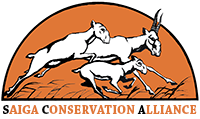Sergelen Erdenebaatar is 25 years old and works as a biologist and ecologist at Altain Nuudelchid, an NGO based in Mongolia. Sergelen is one of the SCA’s 2014 Young Conservation Leaders and he used his award to carry out research into Mongolian saiga populations.
Sergelen , can you tell me a little about your project?
Up until now the calving sites of the saiga population that habit Durgun Khuren Tal, an area of 1173 square km, and one of the main saiga habitats in Mongolia, hasn’t been studied. This means that there are no conservation measures in place, which is essential as on the other side of Durgun most of the saiga poaching occurs. I carried out a calving area identification survey from June to August with the support of local rangers and 1 university student. We carried out the survey using transects.
What was the highlight of the project for you?
Until now we had no idea where the saiga calving areas were in Durgun Khuren, and it was wonderful to locate them with the help of this award. I also presented my findings at the University of Khovd’s scientific conference; my paper “Durgun Steppe Saiga Breeding Research Report” was awarded second place.
What was the biggest challenge of the project?
During summer time it’s very hot, the sun is relentless and it was really hard to work out in the field.
What is the most important thing that you have learnt this year?
I gained great experience in carrying out transects, collecting and processing the data, as well as learning ARC-GIS, many of these skills I was able to pass on to the rangers and student assisting me.
What would you like to do next to help with saiga conservation?
I would like to re-visit the study site in 2015 to repeat the survey. I aim to use all the information I have gained so far to insure that management procedures are put in place in order to conserve the saiga more effectively.
